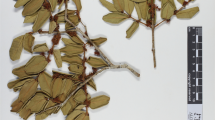Abstract
Ongoing taxonomic studies on Manihot in Brazil based on field collections and herbarium consultations led us to describe a new species and to make other taxonomic and nomenclatural changes in the genus. Manihot minimiflora is described and illustrated as a new species from Tocantins state in northern Brazil. Along with M. sagittatopartita and M. acuminatissima, it has the smallest flowers in the genus. However, M. minimiflora can be easily differentiated from its closest relatives by its shrubby habit, androecium with eight stamens, 8-lobed staminate disc, differently shaped bracts and bracteoles of the staminate flowers, calyces of both sexes lacking any purplish or reddish pigmentation, and shorter seeds. A conservation assessment and data on the phenology, distribution, and morphology of the new species are provided. We also provide distribution maps, morphological characterization, and conservation status assessments for M. acuminatissima, M. longipetiolata, M. sagittatopartita, M. salicifolia, M. stricta, and M. weddelliana, as well as discuss their morphological relationships. Lectotypifications are provided for those six species and for two synonyms, M. riedeliana and M. mattogrossensis.




Similar content being viewed by others
Literature cited
Allem, A. C. 1989. Four new species of Manihot (Euphorbiaceae) from Brazil. Revista Brasileira de Biologia 49: 649–662.
Bachman, S., J. Moat, A. Hill, J. de la Torre & B. Scott. 2011. Supporting Red List threat assessments with GeoCAT: Geospatial Conservation Assessment Tool. ZooKeys 150: 117–126.
Baillon, H. 1863. Euphorbiaceés Americaines. Adansonia 4: 257–377.
Chagas, R. P. 2007. Políticas territoriais no estado de Tocantins: um estudo de caso sobre o Jalapão. Masters thesis. Departamento de Geografia da Faculdade de Filosofia, Letras e Ciências Humanas da Universidade de São Paulo.
Duputié, A., J. Salick & D. Mackey. 2011. Evolutionary biogeography of Manihot (Euphorbiaceae), a rapidly radiating Neotropical genus restricted to dry environments. Journal of Biogeography 38: 1033–1043
Figueiredo, I. B. 2007. Efeito do fogo em populações de capim dourado (Syngonanthus nitens, Eriocaulaceae) no Jalapão, TO. Masters thesis. Universidade de Brasília, Brasília.
Flora do Brasil 2020. 2019, underway. Manihot. Jardim Botânico do Rio de Janeiro. Available from: http://floradobrasil.jbrj.gov.br/reflora/floradobrasil/FB17591 (accessed 2 July 2019)
IUCN. 2012. IUCN Red List categories and criteria. Version 3.1. 2nd ed.. IUCN, Gland, Switzerland and Cambridge, UK. http://www.iucnredlist.org/technical-documents/red-list-training/red-list-guidance-docs
IUCN Standards and Petitions Subcommittee. 2017. Guidelines for using the IUCN red list categories and criteria. Version 13. IUCN, Gland, Switzerland and Cambridge, UK http://cmsdocs.s3.amazonaws.com/RedListGuidelines.pdf
Martins, S. V., E. R. Brito, A. T. O. Filho, A. F. Silva & E. Silva. 2008. Floristic composition of two wetland forests in Araguaian Plain, State of Tocantins, Brazil, and comparison with other areas. Revista Árvore 32: 129–141
Müller Argoviensis, J. 1874. Euphorbiaceae. In: C. F. P. Martius & A. W. Eichler (eds.) Flora Brasiliensis. Munich, vol. 11: 1–752
Pax, F. 1910. Manihot Adans. Pp. 21–111. In: H. G. A. Engler (ed.) Das Pflanzenreich IV. 147 II, Heft 44. Wilhelm Engelmann.
Pohl, J. E. 1827. Plantarum brasilie icones et descriptiones hactenus ineditae. Vindobonae.
Proença, C. E. B., R. Farias-Singer & B. M. Gomes. 2007. Pleonotoma orientalis (Bignoniaceae–Bignonieae): expanded description, distribution and a new variety of a poorly known species. Edinburgh Journal of Botany 64: 17–23.
Ribeiro, J. F. & B. M. T. Walter. 2008. As principais fitofisionomias do Bioma Cerrado. Pp.151–212. In: S. M. Sano, S. P. Almeida & J. F. Ribeiro (eds.), Cerrado: ecologia e flora. Embrapa Cerrados, Planaltina, Brazil.
Rogers, D. J. & S. G. Appan. 1973. Manihot and Manihotoides (Euphorbiaceae). A computer-assisted study. Flora Neotropica, Monograph. No. 13. Hafner Press, New York.
Santos, R. P., A. Crema, M. A. Szmuchrowski, K. Asano & M. Kawaguchi. 2011. Atlas do Corredor Ecológico da Região do Jalapão. Instituto Chico Mendes de Conservação da Biodiversidade.
Silva, M. J. 2015. Manihot veadeirensis (Euphorbiaceae s.s.): A new species from the Brazilian Cerrado. Systematic Botany 39: 1161–1165.
Silva, M. J., Inocencio, L. S. & Alonso, A. A. 2016. Manihot allemii sp. nov. (Euphorbiaceae s.s.) with entire and unlobed leaves from northern Brazil, with notes about foliar anatomy. Nordic Journal of Botany 34: 134–140.
Silva, M. J., Soares, T. N. & Oliveira, P. R. O. 2017. Morphological characteristics and genetic evidence reveals a new species of Manihot (Euphorbiaceae, Crotonoideae) from Goiás, Brazil. Phytokeys 77: 99–111.
Scariot, A. O., T. B. Cavalcanti, A. C. Sevilha, A. B. Sampaio, M. Carvalho-Silva, & G. Pereira-Silva. 2002. Flora e vegetação do entorno do Parque Estadual do Jalapão (TO): Relatório de Atividades. EMBRAPA. Brasília.
Steudel, E. T. 1840. Nomenclator Botanicus ed. 2, 1. J. G. Cottae, Stuttgart and Tübingen.
Thiers, B. 2019. Index Herbariorum, a global directory of public herbaria and associated staff. New York Botanical Garden’s Virtual Herbarium. http://sweetgum.nybg.org/ih/. (Searched 8 May 2019).
Turland, N. J., J. H. Wiersema, F. R. Barrie, W. Greuter, D. L. Hawksworth, P. S. Herendeen, S. Knapp, W.-H. Husber, D.-Z. Li, K. Marhold, T. W. May, J. McNeill, A. M. Monro, J. Prado, M. J. Price & G. F. Smith. 2018. International Code of Nomenclature for algae, fungi, and plants (Shenzhen Code) adopted by the Nineteenth International Botanical Congress Shenzhen, China, July 2017. Regnum Vegetabile 159. Koeltz Botanical Books, Glashütten.
Viana, R. V. R., P. T. Sano & V. L. Scatena. 2014. Pesquisa de campo como possibilidade de concretizar oportunidades de diálogo: Experiência em duas comunidades artesãs do Jalapão-TO. Revista de Desenvolvimento Social 13: 57–67.
Acknowledgments
The authors thank the Conselho Nacional de Desenvolvimento Científico e Tecnológico (CNPq) for a productivity grant (Process no. 307371/2013–1), Cristiano Gualberto for the illustrations, and Dr. Paul E. Berry for comments on an earlier version of the manuscript and corrections to the English writing.
Author information
Authors and Affiliations
Corresponding author
Rights and permissions
About this article
Cite this article
da Silva, M.J., do Amaral, U.S. Novelties in wild cassava (Manihot, Euphorbiaceae) from Brazil. Brittonia 72, 164–176 (2020). https://doi.org/10.1007/s12228-019-09602-y
Published:
Issue Date:
DOI: https://doi.org/10.1007/s12228-019-09602-y




